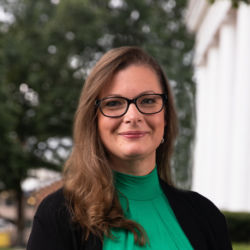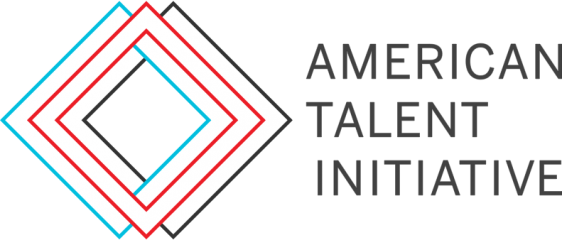Centre College Bolsters First-Generation Student Success Through Cohort Scholarship Programs
An interview with Sarah Scott, director of the Grissom Scholarship Program
Yazmin Padilla
May 5, 2022
Reading Time: 4 minutes

Imagine: You’re working at a four-year college that wants to increase first-generation student enrollment. Your campus has great academic supports, buzzing campus life, and leadership that’s all in. Your college has just received one of the biggest donations in the history of your state, dedicated to endowing a program for increasing first-generation enrollment and supporting college success. You will be the person to lead the creation of this new program.
This was the enviable challenge of Sarah Scott, director of the Grissom Scholars Program at Centre College in Danville, Kentucky. A small private university founded in 1819, Centre has about 1,300 students.
Before the Grissom Scholars Program was launched in 2015, first-generation student enrollment hovered close to 9 percent. Fast forward seven years: 20 percent are first-generation college students. Yet, the Grissom program accepts only ten scholars a year.
How did a small number of scholarships more than double first-gen enrollment? The American Talent Initiative, part of the Aspen Institute College Excellence Program, interviewed Sarah Scott to learn how these scholarships helped transform the campus.
Can you tell us more about the Grissom program and what inspired you to make it a model for cohorts of scholarship students?
This started when Centre College alumnus David Grissom and his wife, Marlene Grissom, who are passionate about providing opportunities to students, made a substantial donation to set up the scholarship. Scott then dedicated a year to researching scholarship programs across the country. She was particularly inspired by the Posse model as well as the Robinson program at the University of Kentucky. Both focus on improving outcomes by creating a set of experiences shared by a diverse cohort of students, and providing specialized support throughout their time in college.
Scott created a program that inducts 10 first-generation college students every year. The scholarship covers tuition over four years, and Centre College provides additional aid to cover room and board, books, and transportation to meet full financial need.
Scott realized that it takes more than financial help for scholars to achieve success, so the Grissom Scholars Program draws from best practices in mentoring, leadership training, and group bonding activities. The awards include $5,000 in educational enrichment and travel funds, allowing students to pursue unpaid internships, purchase technology, and study abroad. To make sure family members are involved, the program reimburses up to $1,500 for relatives to attend Family Weekend during the first year of college. Grissom sets aside money for emergencies (recently allowing a student to fly home to a grandparent in critical condition).
What is unique about the selection process for the Grissom Scholarship program?
Centre considers all students who identify as first-gen when applying for general admission, even if they aren't aware the scholarship exists. As counselors review applicants, they nominate exceptional first-gen students. A separate selection committee then chooses the cohort of Grissom Scholars. This “invisible” application process acknowledges high school seniors often feel too overwhelmed to apply for scholarships as they balance studying and applying to college.
Scott says the committee seeks six traits: dedication to high academic achievement; strong character and leadership potential; persistence and motivation to achieve goals; creative problem solving and innovation; significant involvement in extracurricular activities, such as the arts, community life, service, and paid or unpaid work; and the ambition and intellectual curiosity to succeed in a rigorous academic environment.
So how does a program that inducts only 10 students a year increase the college’s first-generation student enrollment from 9 percent to 20 percent?
The application may be invisible, but Centre's admissions counselors regularly elevate the program as a recruitment tool. Students reach out to learn more and then apply to the college, hoping to receive a Grissom scholarship. Many who do not receive this particular scholarship still receive generous aid from Centre College and choose to attend. This increased first-gen enrollment by 11 percentage points, making the campus more diverse and more of a reflection of the face of the United States.
Scott and her team then created programs to serve Grissom Scholars. A library in Scott’s office serves as a hub for textbook exchanges, saving many students from buying or renting expensive materials. The college now has a Centre’s Firsts Club, where first-gen students connect. As programming increased to ensure first-gen success, retention improved. Of the first class of Grissom scholars, 100% persisted to graduation. Overall, the program has a 93% graduation rate.
As an unexpected bonus, resources developed for the Grissom program have benefited all students on campus. For example, every first-year student now has access to a glossary that was developed for Grissom Scholars. It explains the sometimes bewildering terms and colloquialisms used at Centre–words that can be daunting to new students.
What advice do you have for ATI members who would like their boards and potential donors to support scholarships like this?
Centre College is lucky, Scott acknowledges. Not every institution has a driving force like David Grissom, who is a board member, advocate for student access, and donor of funds to build transformative programs. However, Scott likes to share two lessons of engagement that can be applied to any board or donor.
First: Share data about the success of the program with the board. A college can quantify the benefits of a cohort scholarship program. When students from families with low incomes are relieved of the financial burden of college and offered specialized support, they can thrive. The numbers offer proof: gaps in retention and graduation begin to close. For donors interested in making an impact, it’s reassuring to see these models show success time and time again.
Second: Pair data with student stories to generate support from board members. For instance, Scott shared one anecdote about the Grissom program changing the life of a DACA student and her family. The opportunity of a college education expanded beyond the student. Her younger sister also went to college, and their mother learned English. The scholarship didn’t just benefit the student or the campus; it helped a whole community beyond Centre.
Centre’s board is encouraged by the initial success, Scott says. Driven by the belief that Centre should not be out of reach for anyone, the board supports plans to develop more cohort programs. For example, Centre is expanding its POSSE program to induct a second cohort of 10 scholars every year. “I would love to see us keep growing until every student is in a cohort program,” Scott says.
Centre is now one step closer to realizing Scott’s dream. Centre recently received a $1 million grant from Bloomberg Philanthropies and the Wilpon Family Foundation to establish a Kessler Scholars program that builds on the strong foundations of the Grissom program. With the award, Centre joins a network of 16 institutions in the Kessler Scholars Collaborative. Through the Collaborative, Scott can share and grow her expertise in serving first-generation, limited-income students.
Interested in learning more about how to support students from low-income backgrounds with cohort programs? Check out our partners at the Kessler Scholars Collaborative!


